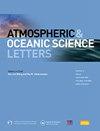Compound extreme events and health risks in China: A review
IF 3.2
4区 地球科学
Q3 METEOROLOGY & ATMOSPHERIC SCIENCES
引用次数: 0
Abstract
Against the backdrop of global warming, China has been facing increasingly frequent and severe extreme weather and climate events, with a prominent risk of compound extreme events induced by interactions among multiple climate drivers and/or hazards. The present study first reviews the definition and classification of compound extreme events in China. Then, it summarizes research progress on the evolutionary characteristics, formation mechanisms, and future projections of different types of compound extreme events. The potential risks and possible impact pathways of three specific event types—namely, continuous day–night hot extremes, temperature–humidity compound events, and high-temperature–ozone compound events—on the health of the Chinese population are then explored. Finally, a framework for assessing the hazard risk of compound extreme events is constructed, accompanied by response strategies based on carbon neutrality targets. Building on existing research achievements, five future research directions are proposed: (1) identifying the risk chains of compound events; (2) addressing the constraints of observational records and coupled model performances; (3) attributing and understanding the drivers of compound extreme events; (4) finding optimal pathways for carbon reduction and air quality improvement; and (5) promoting inter-disciplinary, multi-regional, and cross-sectoral collaboration. Strengthening research in these directions will deepen our understanding of compound extreme events and provide technological support for climate change adaptation and health risk responses in China.
摘要
在全球变暖的背景下, 中国面临着日益频繁和严峻的极端天气气候事件, 其中以多种气候驱动因子和/或灾害相互作用而形成的复合型极端事件风险尤为突出. 本文首先回顾了中国区域复合型极端事件的定义与分型; 然后综述了不同类型复合型极端事件的演变特征, 形成机制以及未来预估等方面的研究进展; 随后, 探讨了日夜持续型极端高温事件, 温湿复合事件以及高温–臭氧复合事件等三类事件对我国人群健康的潜在风险及可能的影响途径; 最后, 阐述了复合型极端事件灾害风险评估框架, 并在此基础上提出了基于碳中和目标的应对策略. 在总结既有研究成果的基础上, 提出了五个未来亟需关注的研究方向: (1)复合事件灾害风险链的识别问题; (2)观测资料和耦合模式性能的制约问题; (3)复合型极端事件的归因与成因问题; (4)碳减排与空气质量改善的最优路径问题; (5)多学科, 多区域, 多部门的合作问题. 加强上述方向的研究有助于深化对复合型极端事件的理解, 并为我国气候变化适应和健康风险应对提供科技支撑.
中国复合极端事件与健康风险综述
在全球气候变暖的大背景下,中国极端天气和气候事件日益频繁和严重,多种气候驱动因素和灾害相互作用导致的复合极端事件风险突出。本文首先回顾了中国复合极端事件的定义和分类。总结了不同类型复合极端事件的演化特征、形成机制及未来预测等方面的研究进展。探讨了连续昼夜极端高温事件、温湿度复合事件和高温臭氧复合事件三种特定事件类型对中国人口健康的潜在风险和可能的影响途径。最后,构建了复合极端事件危害风险评估框架,并提出了基于碳中和目标的应对策略。在现有研究成果的基础上,提出了未来的五个研究方向:(1)识别复合事件的风险链;(2)解决观测记录和耦合模式性能的约束;(3)复合极端事件的归因和驱动因素的认识;(4)寻找减少碳排放和改善空气质量的最佳途径;(5)促进跨学科、多地区、跨部门合作。加强这些方向的研究将加深我们对复合极端事件的认识,并为中国适应气候变化和健康风险应对提供技术支持。摘要在全球变暖的背景下, 中国面临着日益频繁和严峻的极端天气气候事件, 其中以多种气候驱动因子和/或灾害相互作用而形成的复合型极端事件风险尤为突出. 本文首先回顾了中国区域复合型极端事件的定义与分型; 然后综述了不同类型复合型极端事件的演变特征, 形成机制以及未来预估等方面的研究进展; 随后, 探讨了日夜持续型极端高温事件, 温湿复合事件以及高温–臭氧复合事件等三类事件对我国人群健康的潜在风险及可能的影响途径; 最后, 阐述了复合型极端事件灾害风险评估框架, 并在此基础上提出了基于碳中和目标的应对策略. 在总结既有研究成果的基础上, 提出了五个未来亟需关注的研究方向: (1)复合事件灾害风险链的识别问题; (2)观测资料和耦合模式性能的制约问题; (3)复合型极端事件的归因与成因问题; (4)碳减排与空气质量改善的最优路径问题; (5)多学科, 多区域, 多部门的合作问题. 加强上述方向的研究有助于深化对复合型极端事件的理解, 并为我国气候变化适应和健康风险应对提供科技支撑.
本文章由计算机程序翻译,如有差异,请以英文原文为准。
求助全文
约1分钟内获得全文
求助全文
来源期刊

Atmospheric and Oceanic Science Letters
METEOROLOGY & ATMOSPHERIC SCIENCES-
CiteScore
4.20
自引率
8.70%
发文量
925
审稿时长
12 weeks
 求助内容:
求助内容: 应助结果提醒方式:
应助结果提醒方式:


